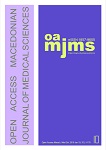Correlation between Serum 25-Hydroxyvitamin D Levels with Keloid Severity
DOI:
https://doi.org/10.3889/oamjms.2019.022Keywords:
Serum 25-hydroxyvitamin D level, Keloid severityAbstract
BACKGROUND: Keloids are dermal fibroproliferative tumours characterised by excessive deposition of extra cellular matrix components. The active form of vitamin D is known to inhibit the proliferation of keloid fibroblasts by inhibiting extracellular matrix production induced by transforming growth factor ß (TGF-β) and increasing matrix metalloproteinase (MMP) activity. Vitamin D derivatives are thought to be an early preventive treatment strategy for keloid.
AIM: To determine the correlation between serum 25-hydroxyvitamin D level with keloid severity.
METHODS: This is a cross-sectional analytic study involving 32 keloid patients. Keloid patients were diagnosed by history and clinical examinations. Then an assessment of the severity was conducted using the Vancouver Scar Scale (VSS). We conducted blood sampling and measurement of serum 25-hydroxyvitamin D level to the patients. This study has been approved by the Health Research Ethics Commission of the Faculty of Medicine, Universitas Sumatera Utara, H. Adam Malik General Hospital Medan.
RESULTS: There is negative correlation between serum 25-hydroxyvitamin D level with severity in keloid patients (p = 0.0001; r = -0.737). There is no significant correlation between serum 25-hydroxyvitamin D level with gender (p = 0.271), age (p = 0.201; r = -0.232), duration of keloid (p = 0.505; r = -0.122) and family history (p = 0.262).
CONCLUSION: Lower level of plasma 25-hydroxyvitamin D, the severity of keloid became an increasingly heavy. There is no significant difference between serum 25-hydroxyvitamin D level with gender, age, duration of keloid and family history in keloid patients.
Downloads
Metrics
Plum Analytics Artifact Widget Block
References
Burrows NP, Lovell CR. Disorders of connective tissue. Rook's textbook of dermatology. 2004:2241-312. DOI: https://doi.org/10.1002/9780470750520.ch46
Seo BF, Lee JY, Jung SN. Models of abnormal scarring. BioMed research international. 2013; 2013. DOI: https://doi.org/10.1155/2013/423147
Holick MF. Vitamin D: importance in the prevention of cancers, type 1 diabetes, heart disease, and osteoporosis. Am J Clin Nutr. 2004; 79:362-71. https://doi.org/10.1093/ajcn/79.3.362 PMid:14985208 DOI: https://doi.org/10.1093/ajcn/79.3.362
Yu D, Shang Y, Luo S, Hao L. The TaqI Gene Polymorphisms of VDR and the Circulating 1,25-Hydroxyvitamin D Level Confer the Risk for Keloid Scarring in Chinese Cohorts. Cell Physiol Biochem. 2013; 32:39-45. https://doi.org/10.1159/000350121 PMid:23867793 DOI: https://doi.org/10.1159/000350121
Koleganova N, Piecha G, Ritz E, Gross M. Calcitriol ameliorates capillary deficit and fibrosis of the heart in subtotally nephrectomized rats. Nephrol Dial Transplant. 2009; 24: 778-87. https://doi.org/10.1093/ndt/gfn549 PMid:18829613 DOI: https://doi.org/10.1093/ndt/gfn549
Dong X, Mao S, Wen H. Upregulation of proinflammatory genes in skin lesions may be the cause of keloid formation (Review). Biomedical Reports. 2013; 1:833. https://doi.org/10.3892/br.2013.169 PMid:24649037 PMCid:PMC3917036 DOI: https://doi.org/10.3892/br.2013.169
Lee DE, Trowbridge RM, Ayoub NT, Agrawal DK. High-mobility Group Box Protein-1, Matrix Metalloproteinases, and Vitamin D in Keloid and Hypertrophic Scar. PRS Global Open. 2015; 1-9. DOI: https://doi.org/10.1097/GOX.0000000000000391
Fearmonti R, Bond J, Erdmann D, Levinson H. A Review of Scar Scales and Scar Measuring Devices. Journal of Plastic Surgery. 2010; 10:354-63.
Nicholas RS, Falvey H, Lemonas P, Damodaran G, Selim F, Navsaria H, et al. Patient-Related Keloid Scar Assessment and Outcome Measures. Plastic and Reconstructive Surgery. 2012; 129(3):648-56. https://doi.org/10.1097/PRS.0b013e3182402c51 PMid:22373972 DOI: https://doi.org/10.1097/PRS.0b013e3182402c51
Medikawati IGAAR, Praharsini IGAA, Wardhana M. Kadar 25-hydroxyvitamin D Plasma Berkorelasi Negatif dengan Derajat Keparahan pada Penderita Keloid [thesis]. Denpasar:Universitas Udayana, 2015.
Zhang GY, Cheng T, Luan Q, Liao T, Nie CL, Zheng X, et al. Vitamin D: a novel therapeutic approach for keloid, an in vitro analysis. British Journal of Dermatology. 2011; 164:729-37. https://doi.org/10.1111/j.1365-2133.2010.10130.x PMid:21070203 DOI: https://doi.org/10.1111/j.1365-2133.2010.10130.x
Harant H, Wolff B, Lindley IJD. 1α,25-dihydroxyvitamin D3 decreases DNA binding of nuclear factor-kB in human fibroblast. FEBS Letters. 1998; 436:329-34. https://doi.org/10.1016/S0014-5793(98)01153-3 DOI: https://doi.org/10.1016/S0014-5793(98)01153-3
Hagenau T, Vest R, Gissel TN, Poulsen CS, Erlandsen M, Mosekilde L, et al. Global vitamin D level about age, gender, skin pigmentation and latitude: an ecologic meta-regression analysis. Osteoporos Int. 2009; 20:133-40. https://doi.org/10.1007/s00198-008-0626-y PMid:18458986 DOI: https://doi.org/10.1007/s00198-008-0626-y
Lu W, Zheng X, Yao X, Zhang L. Clinical and epidemiological of keloid in Chinese patients. Arc Dermatol Res. 2015; 307:109-114. https://doi.org/10.1007/s00403-014-1507-1 PMid:25266787 DOI: https://doi.org/10.1007/s00403-014-1507-1
Downloads
Published
How to Cite
Issue
Section
License
Copyright (c) 2019 Vira Indhiratamin Damanik, Imam Budi Putra, Oratna Ginting

This work is licensed under a Creative Commons Attribution-NonCommercial 4.0 International License.
http://creativecommons.org/licenses/by-nc/4.0







